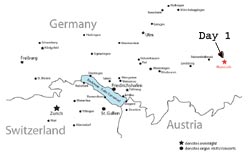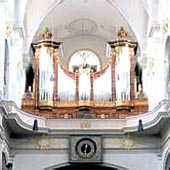Pipedreams Euro-Tour
April 28 - May 11, 2006
Saint Peter’s Church
The first Saint Peter’s Church has been mentioned already before the foundation of the city of Munich in 1158. From this church, parts of the west towers of the Gothic basilica from 1294 are preserved. This tower of a height of 91 meters, landmark of the city, raises as facade to the Marienplatz, the center of downtown Munich. The exterior still has elements dating back into the renaissance time (14th c.) The interior of today’s building is basically the result of Rococo rebuildings in the 18th century, with valuable furnishings, such as the Schrenk altar (1400), the Baroque baptism font and the Rococo side altars, made by Ignaz Guenther. After the damages of WWII, Saint Peter’s Church was restored in 1975-2000.
The present organ with a total of 4.154 pipes has been built by Orgelbau Johannes Klais from Bonn in 2003. The organ has 57 speaking stops (80 ranks) on four manuals and pedal.
Links and resources
 Images from Saint Peter’s, Munich
Images from Saint Peter’s, Munich Find detailed organ specifications in our Tour Book
Find detailed organ specifications in our Tour Book
Saint Michael’s Jesuit Church
The Jesuit Collegiate and their church Saint Michael have been built in 1583-1597 under the reign of Duke Wilhelm V. of Bavaria. It was the first large new church building in Renaissance style North of the Alpes. Many Baroque churches have adapted ideas of the architecture, statues and stuccos that were first realized in Germany in Saint Michael. The new church was consecrated on July 5, 1597. After the abolition of the Jesuit monastery in 1773, the church became Court Chapel of the Wittelsbacher dynasty. Since 1921, Jesuits have returned to St.Michael. The church was badly damaged by bombs in 1944 and has been rebuilt after 1945 in several phases of re-construction.
The gallery organ has been built in 1983 by the organ company Sandtner from Dillingen (Donau) with 64 stops on four manuals and pedal. The historic case from 1698 (made by Johann Hoermann SJ) has been reconstructed by Hans Frank from Burghausen.
Links and resources
 Images from Saint Michael’s, Munich
Images from Saint Michael’s, Munich Find detailed organ specifications in our Tour Book
Find detailed organ specifications in our Tour Book
The day to day…


 Michael Barone’s pictures from the tour
Michael Barone’s pictures from the tour Images from Saint Peter’s, Munich
Images from Saint Peter’s, Munich Images from Saint Michael’s, Munich
Images from Saint Michael’s, Munich Day 2 - Frauenkirche, Saint Franziskus
Day 2 - Frauenkirche, Saint Franziskus Main Tour Page
Main Tour Page



